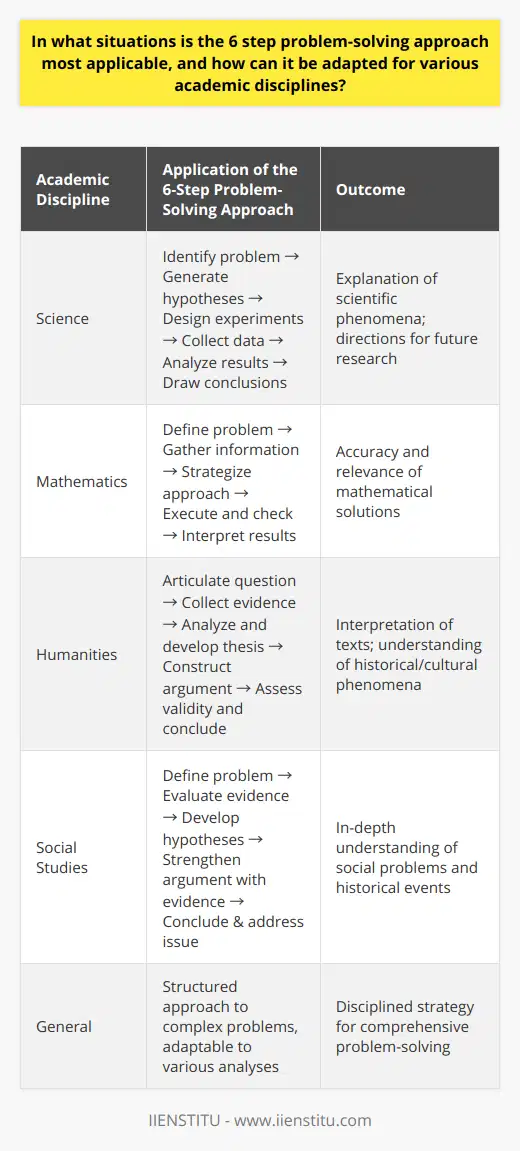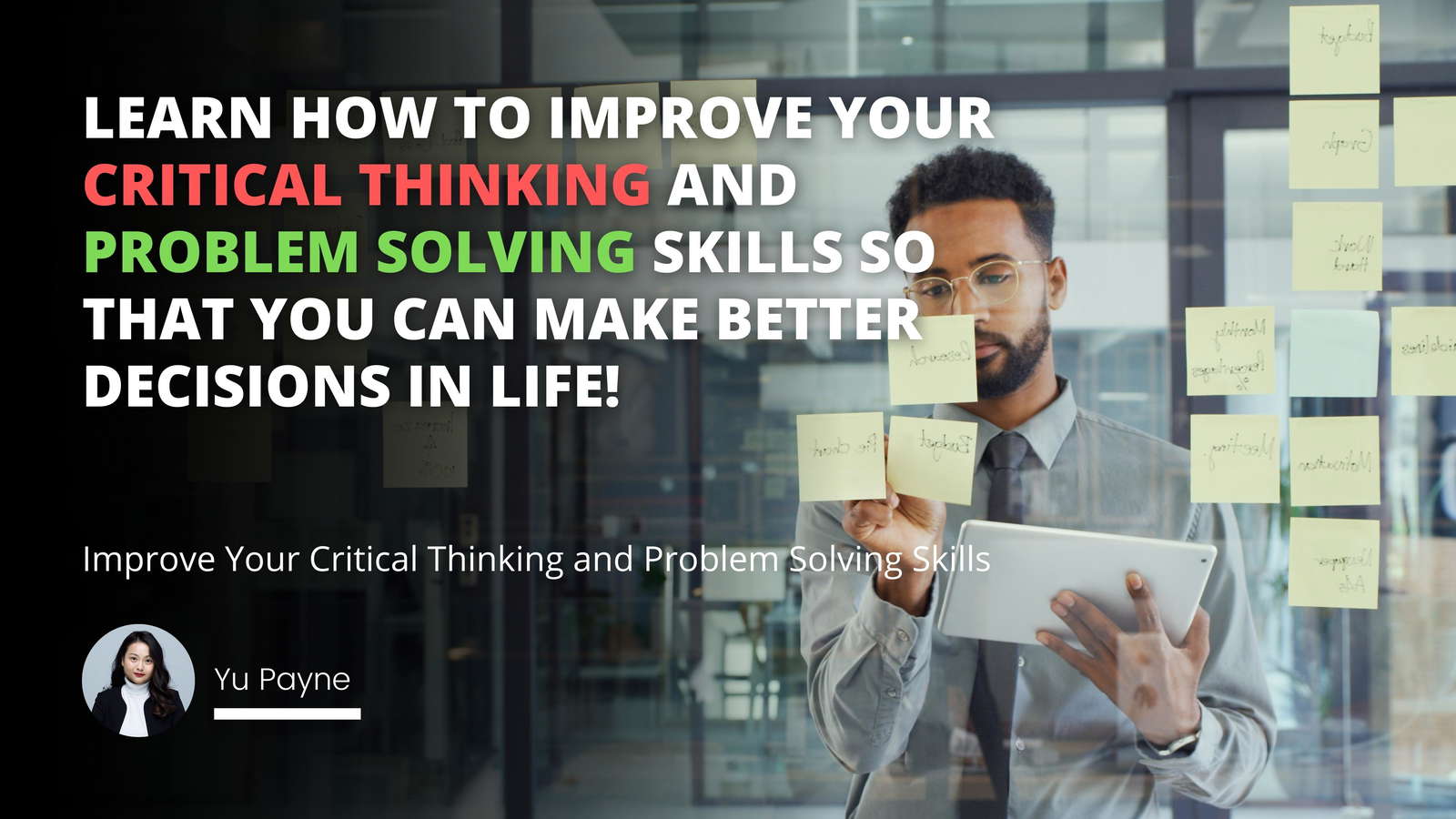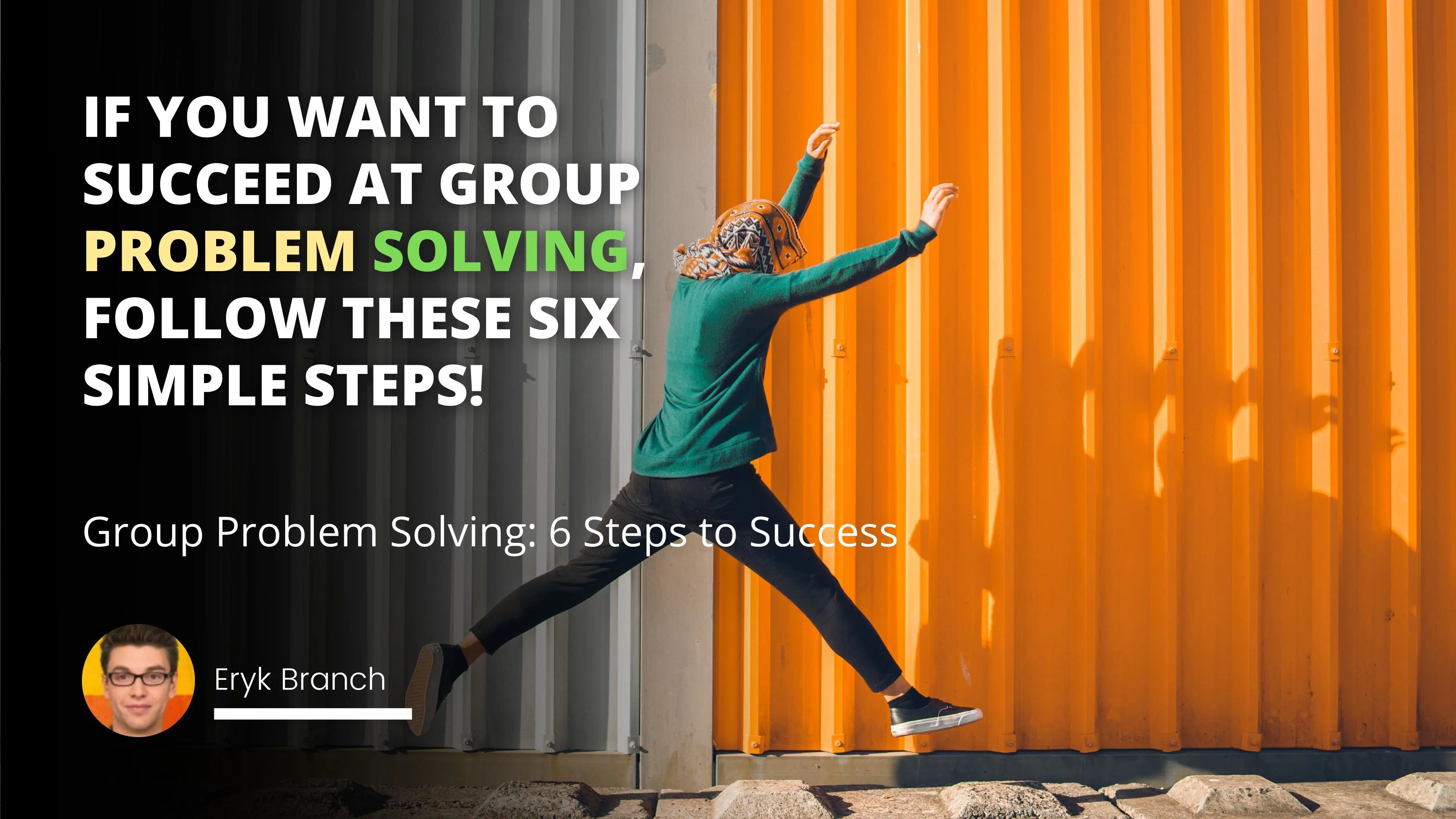
You've been there before. You're in a meeting, and the team is brainstorming solutions to a problem. But no matter how hard you try, you can't develop a good idea. And to make matters worse, everyone else in the room has the same issue. Sound familiar?
Learn how to spot and prevent groupthink, plus six steps to making better decisions as a team.
If you've ever struggled to develop solutions as part of a group, you're not alone. It's a common problem that teams face. But the good news is that there are some things you can do to improve your chances of success. By following these six steps, you'll be on your way to becoming a master of group problem-solving.
Define the problem
The first step in any group problem-solving session is defining the issue. This may seem like an obvious step, but it's one that's often overlooked. With a clear understanding of the problem, it will be easier for the team to generate relevant and impactful ideas.
Brainstorm ideas individually
Once the problem has been defined, it's time for each team member to brainstorm solutions independently. This step is crucial because it allows everyone to develop their unique ideas without pressure from others. Plus, it's often easier to think creatively when you're working on your own.
Share ideas as a group.
After everyone has had a chance to brainstorm independently, it's time to share ideas as a group. This is where things can get tricky, as people tend to get defensive about their thoughts and feel they need to defend them against others' critiques. The key here is to encourage an open exchange of ideas and avoid getting too attached to any one solution.
Evaluate ideas and narrow down options.
Once all the ideas have been shared, it's time to start evaluating them and narrowing down the options. To do this effectively, it's essential to consider both the pros and cons of each idea and how feasible it would be to implement within the given timeframe and budget constraints.
Create an action plan.
After careful evaluation, the team should know which solution or combination is most likely to be successful. The next step is to create an action plan detailing how those solutions will be implemented. This plan should include specific measures, deadlines, and assignees for each task so that everyone knows what needs to be done and when it needs to be done.
Remember that an action plan may need to be revised as new information or unforeseen circumstances arise—and that's okay! The important thing is that there is a plan so everyone knows what needs to happen and who is responsible for making it happen.
Monitor progress and course correction as needed.
The final step is the most important: monitoring progress and course correcting as needed. This step requires regular check-ins so that issues can be identified early on and dealt with before they become more significant problems further down the line. It also allows for adjustments if the original plan isn't working as well as expected or if new challenges arise that weren't anticipated initially—because, let's face it, things rarely go exactly according to plan! By staying flexible and adaptable throughout the process, you'll increase your chances of achieving success.
Group problem-solving can be challenging—but following these six steps can increase your chances of success! Define the problem clearly at the outset, brainstorm ideas individually before sharing them with the group, evaluate all options carefully, create a detailed action plan outlining specific steps, deadlines, and assignees for each task, and regularly monitor progress.
This table not only summarizes the essential concepts but also adds insights into managing potential conflicts and disagreements that may arise during the group problem-solving process. Utilizing these tips can help in creating a more harmonious and productive team environment.
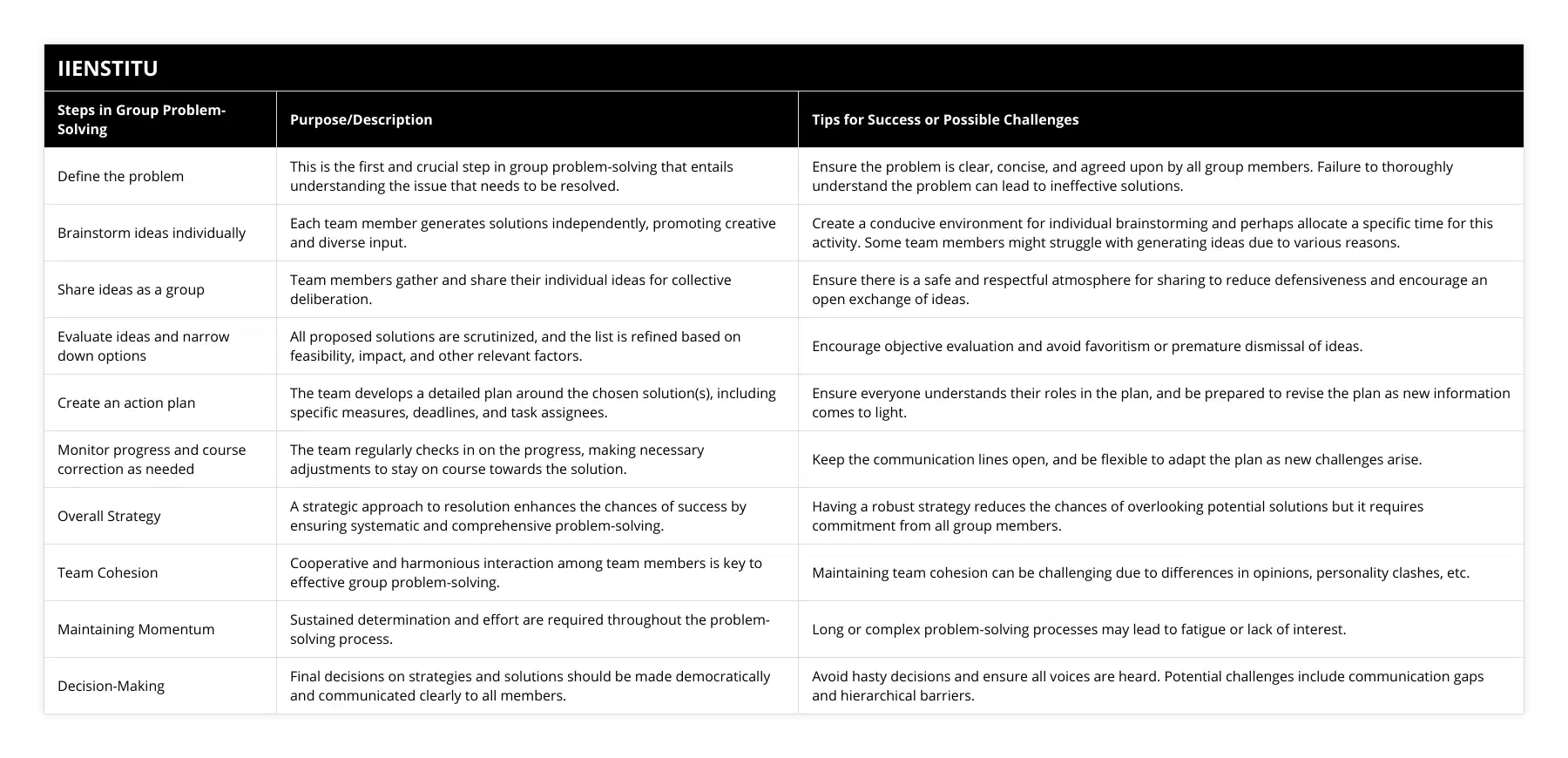
Frequently Asked Questions
How do you go about solving problems with a group?
There's no one-size-fits-all answer to this question, as the best way to solve problems with a group will vary depending on the situation and the group involved. However, some tips on how to effectively solve problems with a group include:
Define the problem.
Come up with potential solutions.
Vote on the best solution.
Implement the chosen solution.
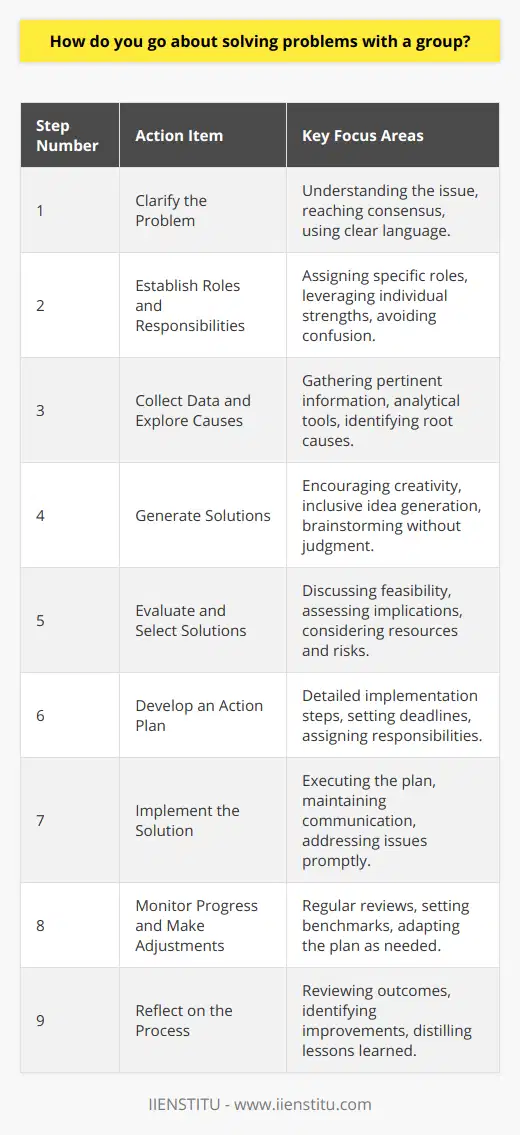
What are some of the best techniques for problem solving with a group?
There are many techniques for problem solving with a group, but the most important factor is that the group be able to work together harmoniously. Some of the best techniques include brainstorming, breaking down the problem into smaller parts, and using a systematic approach.
Brainstorming is a technique where everyone in the group shares their ideas freely, without judgement. This helps to generate a large number of ideas and allows for greater creativity. Breaking down the problem into smaller parts makes it easier to understand and solve. And using a systematic approach ensures that everyone is on the same page and that no steps are missed.

How do you ensure that everyone in the group is heard?
There are a few different ways to ensure that everyone in the group is heard. One way is to make sure that everyone has a turn to speak. Another way is to repeat what someone has said so that everyone can hear. Finally, you can ask people to raise their hands if they want to speak.
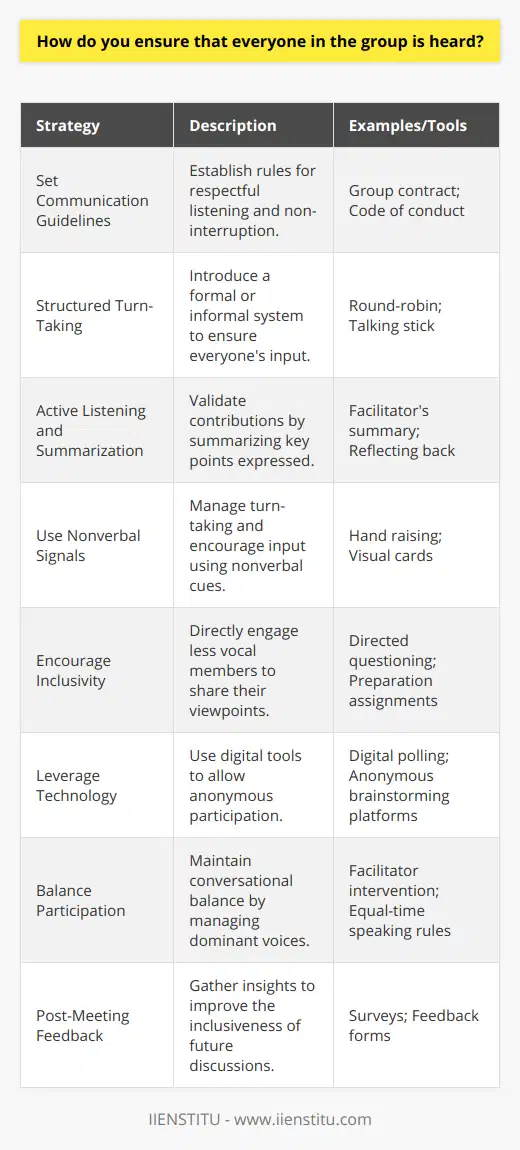
What are the key components of a successful group problem-solving process?
Subheading: Effective Communication and Collaboration
One of the essential components of a successful group problem-solving process is effective communication, which enables group members to articulate their ideas, opinions, and thought processes clearly. By fostering an environment that encourages open and honest dialogue, team members can better understand one another and work towards the common goal of resolving the problem at hand. Collaboration is equally important, as it allows individuals to bring their diverse skills and expertise to the table, creating an environment that facilitates innovation.
Subheading: Clear Goals and Objectives
Another key component is the establishment of clear goals and objectives, which helps in streamlining the group's efforts and keeping them focused on the problem at hand. When all members of a team are aligned and understand the desired outcome, they can collectively work towards achieving it more effectively. This alignment also prevents any potential misunderstandings, and ensures that resources are directed towards the resolution of the problem, as opposed to being wasted on irrelevant tasks.
Subheading: Effective Leadership and Decision-Making
A well-defined leadership structure is vital in guiding the group towards a successful problem-solving outcome. Effective leaders can manage group dynamics, keep team members motivated, and facilitate the decision-making process by assisting in gathering and evaluating relevant information. Additionally, leaders can ensure that responsibilities are assigned and carried out by the most suitable team members, thus maximizing available resources and guaranteeing that everyone is working cohesively.
Subheading: Constructive Conflict Management
In a group setting, it is inevitable that disagreements or conflicts of opinion may arise. As such, effective conflict management is a crucial aspect of the problem-solving process. Constructive conflict management strategies include actively listening to differing viewpoints, finding common ground, and incorporating alternative perspectives into the problem-solving process, which can lead to more inclusive and creative resolutions. By fostering a respectful environment in which such disagreements are handled, the group can remain focused on the task at hand and work towards their goals.
In summary, the key components of a successful group problem-solving process include effective communication and collaboration, clear goals and objectives, effective leadership and decision-making, and constructive conflict management. By integrating these elements, a group will be better equipped to tackle complex problems, fostering innovation and ultimately achieving more successful outcomes.
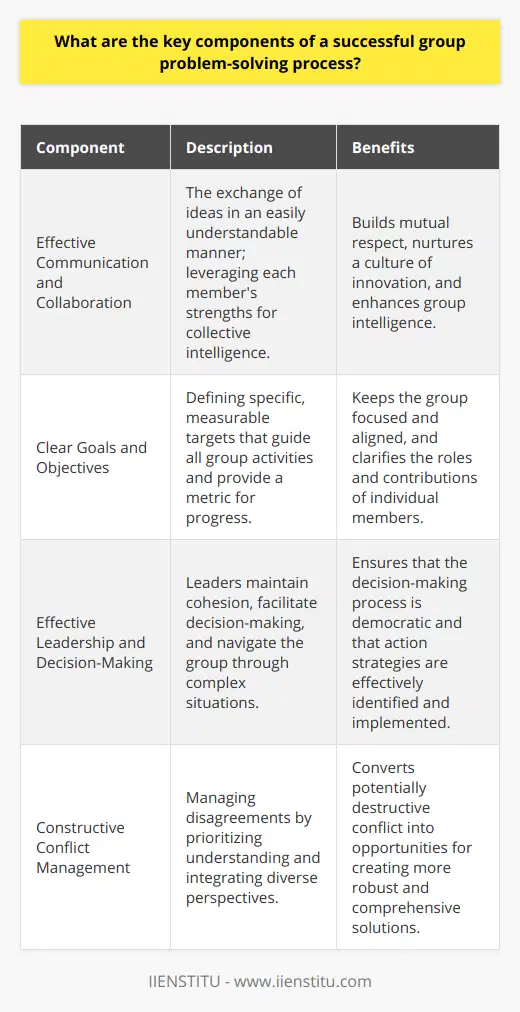
How can group dynamics impact the effectiveness of the 6 steps of problem-solving?
**Influence of Group Dynamics on Problem-Solving Process**
Group dynamics play a crucial role in the effectiveness of the six steps of problem-solving, as they directly influence how individual members contribute to group discussions and decision-making.
**Initial Problem Identification**
The first step, where the problem is identified, calls for group members to communicate openly and honestly. Strong group dynamics, characterized by trust and respect, help to create a safe environment for each member to share their thoughts without fear of criticism. On the other hand, poor dynamics may hinder free expression, leading to a superficial examination.
**Analysis of Problem**
When analyzing the problem, it is essential for the group to have healthy debate and examine different perspectives. A cohesive group, with an emphasis on collaboration, will foster constructive discussions that help to explore the problem from multiple angles. Conversely, a poorly functioning group may encourage dominant members to take control, suppressing diverse opinions and valuable input.
**Generation of Alternative Solutions**
The most effective problem-solving groups are known for their creativity and willingness to explore new ideas. High-quality group dynamics promote brainstorming and evaluation of a wide range of potential solutions, allowing the best ones to be chosen for implementation. Poor dynamics could prevent less confident members from sharing valuable ideas or stifle collaboration, limiting the potential for innovative solutions.
**Decision-Making Process**
As groups move towards decisions, strong group dynamics encourage the active participation of all members. This promotes collective ownership of the final choice and ensures each perspective is considered. In groups with weak dynamics, members may feel excluded or disengaged, leading to a less informed decision with limited buy-in.
**Design and Implementation of Action Plan**
Once a decision has been reached, effective groups quickly develop action plans and assign responsibilities. Members with positive group dynamics exhibit levels of commitment and accountability that result in successful implementation. However, weak dynamics may lead to a reluctance to take responsibility and a lack of motivation to fully see the plan through.
**Evaluation and Reflection**
Lastly, strong group dynamics foster a culture of continuous improvement and learning. Members feel comfortable providing constructive feedback and learning from their experiences, thus setting the stage for more effective problem-solving in the future. In contrast, groups with poor dynamics often struggle to evaluate and learn from their actions, hampering the potential for growth.
In conclusion, group dynamics greatly impact the efficacy of the six steps of problem-solving. Investing in building strong, collaborative relationships within a group ensures both the quality of the problem-solving process and the implementation of chosen solutions.
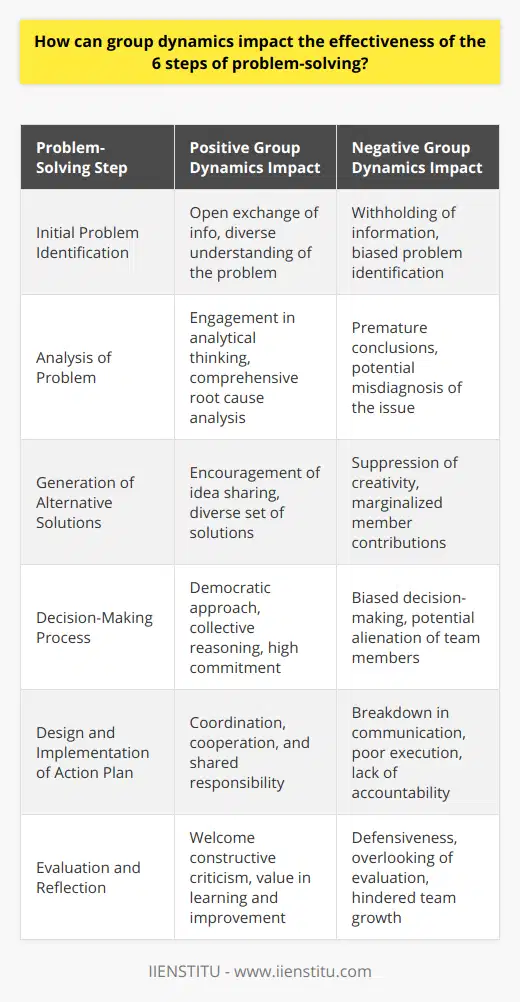
In what ways can the 6 step problem-solving model be adapted to different contexts and challenges?
Adapting the 6-Step Model to Varying Contexts
One approach to adapting the 6-step problem-solving model involves tailoring its components to suit the specific requirements of diverse contexts and challenges. For instance, the first step—identifying the problem—may necessitate a more nuanced approach when tackling complex, multi-dimensional issues that require the input of various stakeholders. In such circumstances, conducting a comprehensive stakeholder analysis becomes essential to ensure that diverse perspectives and needs are considered in the problem definition.
Customizing Data Collection and Analysis
In the information-gathering stage, adapting the model may involve employing diverse methods of data collection and analysis, depending on the nature of the challenge. For example, quantitative data may be more suitable for addressing financial or statistical problems, while qualitative data may be crucial for understanding social or emotional aspects of an issue. Likewise, different analytical techniques, such as descriptive statistics or thematic analysis, can be applied to provide varying levels of insight into the problem space.
Emphasizing Collaboration and Flexibility
During the brainstorming stage, the 6-step model can be adapted to encourage collaboration among team members with diverse skills, experiences, and areas of expertise. This cross-functional approach enables the generation of innovative ideas and solutions that may not emerge from a single-function team. Furthermore, flexibility in the ideation process, including the use of creative thinking tools and techniques, can lead to the development of novel solutions tailored to specific contexts and challenges.
Aligning Solution Evaluation with Context
In evaluating potential solutions, the criteria used to assess their feasibility and effectiveness should be customized to match the context of the problem. For instance, in a business setting, solutions may be evaluated based on their potential for cost savings, revenue generation, or increased customer satisfaction, while in a non-profit or social work environment, other factors, such as community impact or sustainability, may be prioritized.
Tailoring Implementation Strategies
The implementation stage can also be adapted, as different contexts may necessitate varying levels of stakeholder involvement, communication strategies, and resources allocated to ensure the successful execution of the selected solution. In addition, monitoring the progress and assessing the outcomes of implemented solutions should be tailored to the specific context, employing appropriate metrics and indicators that reflect the desired outcomes.
In conclusion, the 6-step problem-solving model can be adapted to different contexts and challenges by customizing its components and processes to align with the unique requirements of the problem space, ensuring the most effective and efficient problem-solving outcomes.
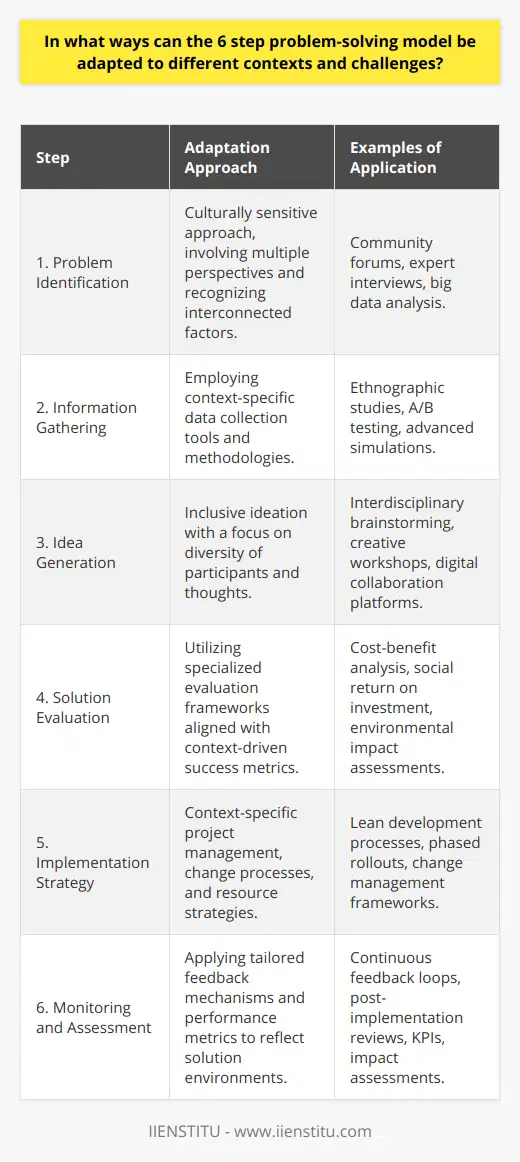
What is the 6 step problem solving approach?
Understanding the Six-Step Problem Solving Approach
The six-step problem solving approach is a systematic and organized method for effectively addressing and resolving issues or challenges. This process ensures a holistic assessment of the problem, formulation of possible solutions, and successful implementation of the optimal resolution. The six steps involved in this method are as follows:
Step 1: Identifying the Problem
In this step, one needs to recognize and clearly define the problem they are experiencing. This involves determining the root causes, any contributing factors, and providing an explicit statement of the issue.
Step 2: Gather Information
By collecting relevant data, statistics, and anecdotes, a clearer understanding of the problem can be attained. This allows for a more accurate analysis, taking into account variables that may be affecting the situation.
Step 3: Generate Alternatives
The next stage involves brainstorming potential solutions to the identified problem. It is crucial to consider multiple options and explore diverse ideas, as this can lead to more innovative and effective solutions.
Step 4: Analyze Alternatives
After generating a list of possible solutions, each one must be carefully analyzed to evaluate its feasibility, advantages, and disadvantages. This step involves comparing and contrasting the potential outcomes based on predetermined criteria or objectives.
Step 5: Select the Best Solution
Once the alternatives have been analyzed, the most suitable solution can be selected based on effectiveness, practicality, and appropriateness to the problem. This decision should be reached through a rational and informed assessment of the options.
Step 6: Implement and Evaluate
Finally, the chosen solution must be carried out and its success evaluated. This involves monitoring the implementation, assessing the outcomes, and possibly revisiting previous steps in the process if the problem persists or unforeseen complications arise.
In conclusion, the six-step problem solving approach provides a comprehensive and structured framework for addressing complex problems, enabling individuals and organizations to identify, analyze, and effectively resolve issues in a systematic and considered manner. By following this approach, one can enhance their decision-making and problem-solving abilities, ultimately leading to improved performance and successful outcomes.
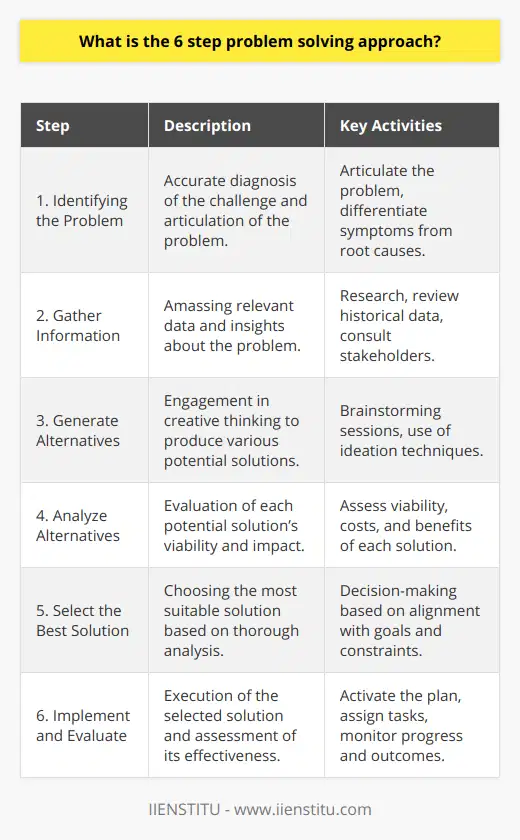
What is the group problem solving model?
Group Problem Solving Model: An Overview
The group problem solving model is a systematic approach employed by collaborative teams to identify, analyze, and address multifaceted issues. It encourages the active participation of diverse members to accommodate various perspectives, knowledge, expertise, and skills that ultimately contribute to achieving an effective and innovative solution.
Phases of Group Problem Solving
The model typically consists of several interconnected phases, each requiring the collective effort and commitment of the team.
Problem Identification
This phase involves collaboratively recognizing a challenge, issue or gap that needs to be resolved. It entails clearly defining the problem, articulating its scope, and highlighting its significance.
Problem Analysis
In this phase, the team delves deeper into understanding the problem, it includes examining the factors contributing to it, evaluating its present and potential impact, and comprehensively assessing its underlying complexities.
Generating Alternatives
Here, group members brainstorm and proffer multiple solutions to the identified problem. They are encouraged to present diverse ideas, which can be assessed for feasibility, effectiveness, and potential challenges they may pose.
Decision Making
After presenting and discussing available alternatives, teams select and prioritize the most viable options. They utilize well-defined criteria, including relevance, applicability, resource requirements, and potential outcomes to guide this process.
Implementation
Once a solution has been agreed upon, the group embarks on its execution. It involves carefully planning, assigning roles, delineating responsibilities, and allocating resources. Progress is monitored, and adjustments are made when necessary.
Evaluation
Lastly, the team assesses the implemented solution's success, taking into account the predefined objectives, expected results, and real-life impact. They reflect on lessons learned, best practices, and areas requiring further improvement.
Benefits and Challenges
Adopting the group problem solving model offers numerous advantages. It enables more comprehensive problem analysis and generates a wider range of potential solutions. The collaboration also fosters improved decision making, as diverse viewpoints challenge assumptions, promote critical thinking, and reduce individual biases.
However, the model may also face several challenges, such as groupthink, conflicts, unequal participation, and time-consuming deliberations. To reap its full potential, teams must establish a supportive culture, promote open communication, and refine individual and collective problem-solving competencies.
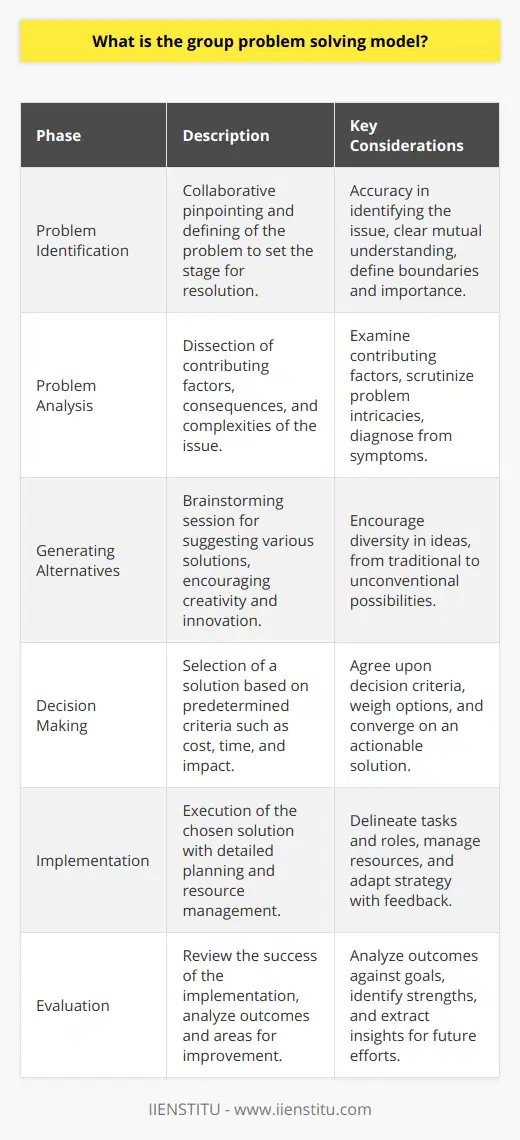
Who created the six step problem solving model?
**Origin of the Six-Step Problem Solving Model**
The six-step problem-solving model traces its origins to the early research contributions of psychologist George Polya. In 1945, Polya published 'How to Solve It,' a book that delineated the groundbreaking problem-solving processes that are now widely taught and applied in numerous fields. This pioneering work introduced a straightforward, easy-to-understand framework for tackling complex problems.
**Polya's Work and Influence**
Polya's seminal book emphasized a practical, systematic approach to problem-solving based on logical and methodological steps. This technique is conducive to fostering a deep understanding of the problem at hand, and the comprehensive formulation of effective solutions. Polya's work has significantly impacted the direction of educational practices, particularly in mathematics and science, where his strategies have been widely adopted.
**Development of the Six-Step Model**
Though the six-step problem-solving model is an outgrowth of Polya's work, it is essential to highlight some distinctions between the two. Polya's original process delineated four main steps, namely understanding the problem, planning the solution, implementing the plan, and reviewing the result. Over time, scholars have expanded on this foundation to develop the six-step problem-solving model. This refined framework provides more detailed and specific guidance, accommodating the intricacies of contemporary problem-solving scenarios.
**Key Components of the Six-Step Model**
The six-step problem-solving model comprises distinct phases, working in tandem to facilitate productive problem-solving. These steps are as follows:
Identifying the problem
Analyzing the problem
Identifying possible solutions
Evaluating and selecting the best solution
Implementing the chosen solution
Monitoring and reviewing the solution
Each step serves a unique purpose, enabling the solver to gain a comprehensive understanding of the initial problem and evaluate potential solutions effectively.
**Conclusion: A Powerful Tool for Problem-Solving**
In conclusion, the six-step problem-solving model originated from the pioneering work of George Polya in the mid-20th century. While Polya's principles laid the groundwork for this model, subsequent scholarly refinements have led to the formulation of the current six-step process. Widely employed as a valuable problem-solving tool across various disciplines, the six-step model has garnered considerable acclaim and solidified its status as an indispensable resource in addressing complex challenges.
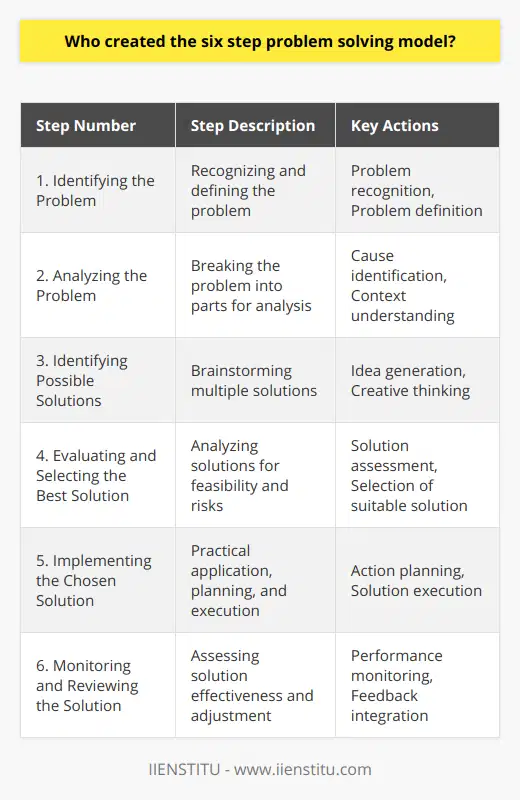
Why is the 6 steps of problem-solving process important?
Importance of the Six-Step Problem-Solving Process
The Underlying Principle
Understanding the six-step problem-solving process is significant as it forms the core principle of solving any kind of problem efficiently. It allows for a structured approach, facilitating effective solutions.
Clarity of Problem
The first two steps involve identifying and understanding the problem. These steps are critical as they set the foundations, ensuring a clear picture of the issue at hand.
Generation of Solutions
Next, solutions are brainstormed and evaluated. These steps prompt creativity and critical thinking. Consequently, a range of potential solutions, along with their feasibility, come to light.
Selecting the Best Solution
The next step involves choosing the best solution. This decision-making stage is crucial to the process. It ensures the selected solution matches the problem's requirements in the most practical and effective way.
Taking Actions
Implementing the chosen solution is the penultimate step. Execution is key because without it, the whole process is vain. It requires ensuring all logistics are in place for smooth operation.
Evaluating the Outcome
The final step is reviewing the outcome to gauge the solution's performance. This step allows for improvements, consolidating learnings from the process. Overall, the six-step problem-solving process guides toward effective solution delivery.
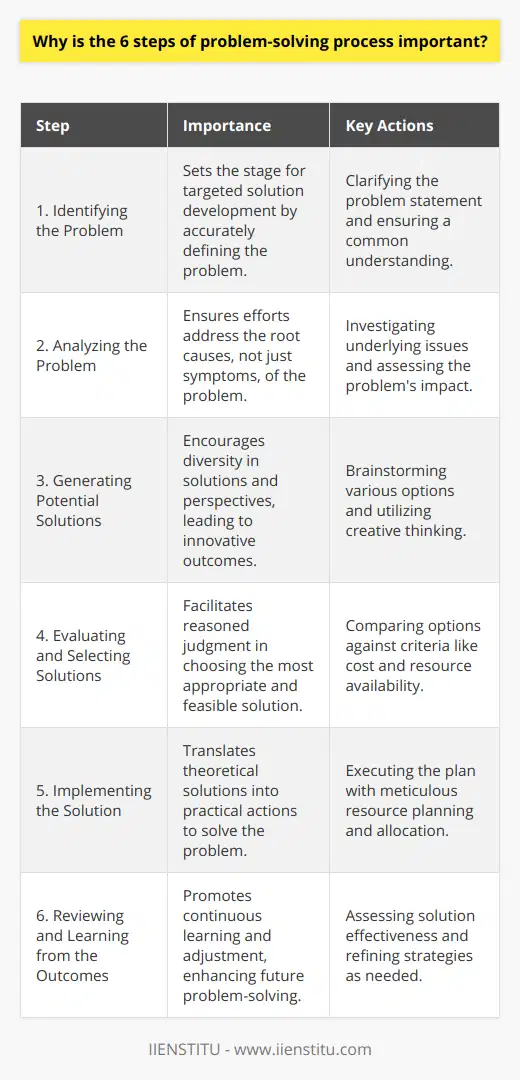
What are the stages of group problem-solving?
Stages of Group Problem-Solving
Group problem-solving involves various stages that ensure effective resolution.
Problem Identification
The initial stage involves identifying the problem. Every member must understand the problem to offer a meaningful contribution.
Analysis Phase
The second stage is the analysis phase. The team delves into the problem to understand its intricacies, helping in generating solutions.
Idea Generation
The third stage encompasses idea generation. Members brainstorm possible solutions to the identified problem.
Decision-Making
Following the brainstorming is the decision-making stage. Here, the group evaluates the proposed solutions and selects the most appropriate one.
Plan Development
The fifth stage involves developing an action plan. The team designs a comprehensive plan to implement the chosen solution.
Implementation Phase
The next stage is the implementation phase. The group takes actionable steps to put their solution into practice.
Evaluation
Finally, there is the evaluation stage. Here, the group assesses the effectiveness of their chosen solution, learning and improving from the experience.
In conclusion, these seven stages of group problem-solving facilitate productive interaction and shared responsibility in finding and implementing solutions. They promote collective engagement, ensure a systematic approach, and enhance the group's ability to tackle complex problems.
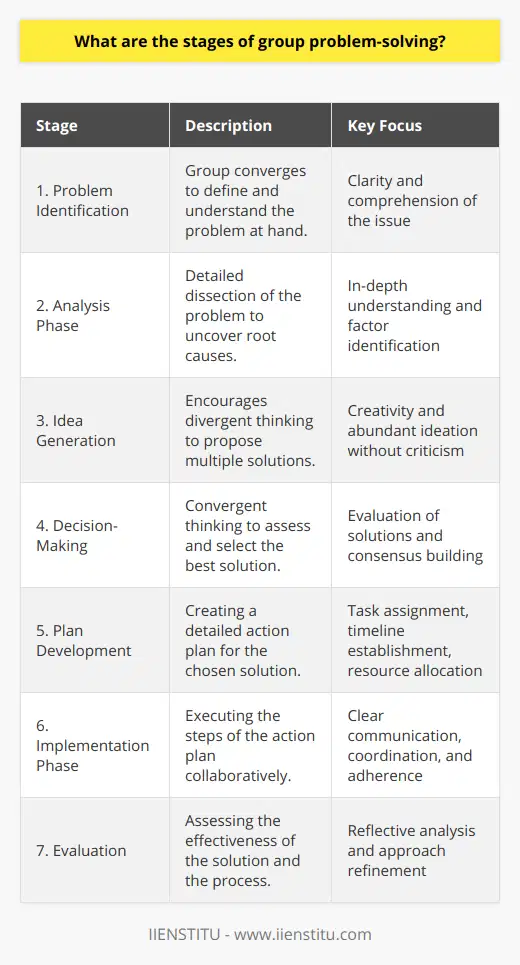
What are the steps for successful problem-solving?
Understanding the Problem
The initial stage in successful problem-solving involves comprehending the question or challenge. We must identify what we need to solve and why.
Gather Relevant Information
Next, we must gather all pertinent information around the problem. This knowledge can come from various sources- documents, observations, or discussions. It aids in further understanding the context and scope of the problem.
Define the Problem and Goal
Researchers need to define the problem concisely. It includes stating the problem in clear, straightforward language and illustrating the existing situation and the desired outcome.
Generate Possible Solutions
In this step, we brainstorm all possible solutions without evaluating or analyzing them. It fuels creative thinking, generating myriad possible solutions.
Evaluate Solutions and Choose the Best
The next move is to evaluate the proposed solutions against our goal. Solutions should be realistic, practical, and achievable. After evaluation, we select the most promising solution.
Implement the Solution
After choosing the best solution, it's time to implement it. This step requires careful planning and managing changes if the solution impacts other people or processes.
Analyze the Outcome
Finally, we must analyze the outcome of the implemented solution, determining whether it successfully solves the problem. If the problem persists, we may need to reassess and select another solution or revise the current one. Thus, effective problem-solving is an iterative process.
In a nutshell, the steps in successful problem-solving involve understanding the problem, gathering relevant information, defining the problem's goal, brainstorming solutions, evaluating and selecting the best solution, implementing it, and finally, analyzing the outcome.
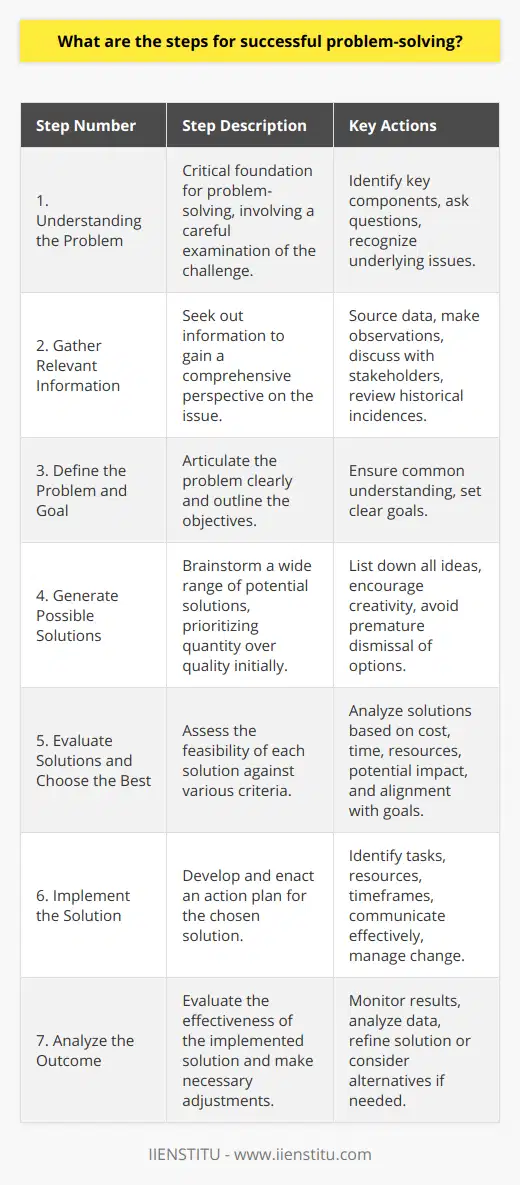
What are the benefits of using the 6 step problem-solving approach in an academic setting?
Benefits of the 6-Step Problem-Solving Approach
The 6-step problem-solving approach offers multiple benefits in an academic setting.
Enhanced Understanding
First, it facilitates a deep understanding of the problem. By breaking the issue down into smaller parts, it allows for a comprehensive grasp of the underlying issues.
Promotion of Creativity
Secondly, this approach is favorable for creativity. It encourages innovative thinking and the generation of multiple solutions, thereby fostering out-of-the-box thinking.
Systematic Process
The systematic process of this methodology is beneficial in academic settings. It provides a clear path for problem resolution, ensuring structured and logical thinking.
Promotes Collaboration
This method promotes collaboration in a group setting. It allows equally distributed participation, fostering a collaborative learning environment.
Increased Confidence
It increases confidence. The structured nature of the 6-step process provides students with assurance about their ability to find solutions.
Learning Retention
Lastly, the 6-step problem-solving approach aids in learning retention. Students learn by doing, ensuring that both the problem and its solution remain ingrained in their memory.
In conclusion, utilizing the 6-step problem-solving method in an academic setting offers a myriad of benefits. It enhances understanding, promotes creativity, ensures a systematic approach, fosters collaboration, builds confidence, and assists with learning retention. It is thus an effective tool to facilitate practical learning.
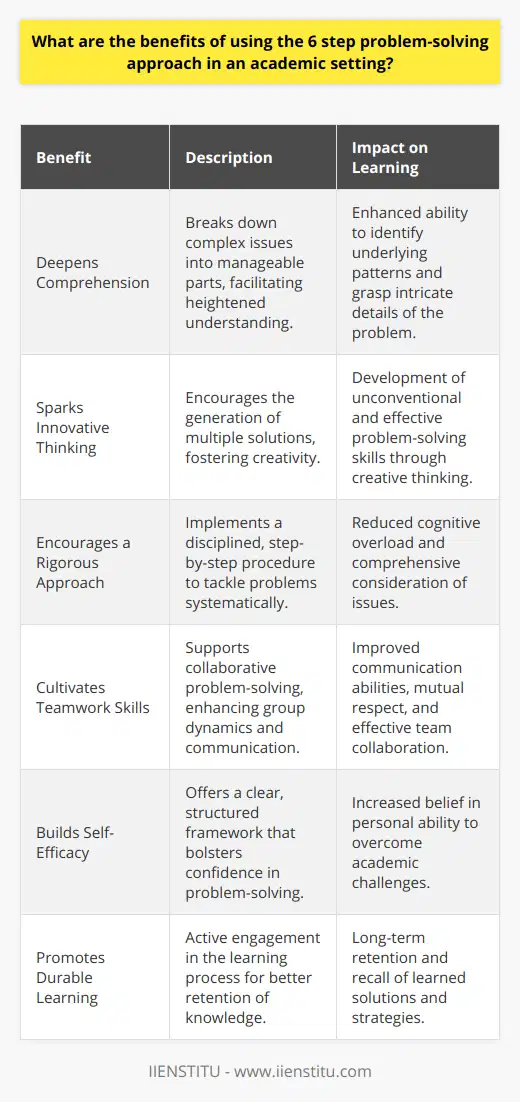
How does the 6 step problem-solving approach enhance the efficiency and effectiveness of group work in academic projects?
Enhancing Efficiency with the Six-Step Problem-Solving Approach
The six-step problem-solving approach improves the efficiency of group work in academic projects. By offering a structured framework, it assists in clarifying the problem and accurately defining the aim. It eliminates ambiguity, allowing each team member to understand the task at hand better.
Guiding through Solution Generation
Secondly, it gives guidance in brainstorming solutions. It promotes creative thinking, encouraging the consideration of multiple viewpoints. The result is a wide range of potential solutions which enhance the group's creativity, and thus the solution's quality.
Stimulating the Decision-Making Process
Thirdly, the approach enhances decision-making. The group evaluates each solution based on its feasibility and impact, leading to a democratic and informed choice. This reduces conflicts within the group, encouraging a collaborative mindset.
Facilitating Plan Development
Then, it helps in formulating a viable plan of action. By assigning roles and responsibilities, it improves productivity and time management within the group. It ensures that everyone understands their role, which boosts group synergy and reduces confusion.
Ensuring Execution and Review
Lastly, the approach guides execution and review. By incorporating a built-in feedback mechanism, it helps adjust the solution if necessary. This proactively addresses any unforeseen challenges, enhancing the project's overall effectiveness.
In conclusion, the six-step problem-solving approach greatly enhances the efficiency and effectiveness of group work in academic projects. Its structure fosters collaboration and creativity while providing a clear roadmap to successfully complete tasks.
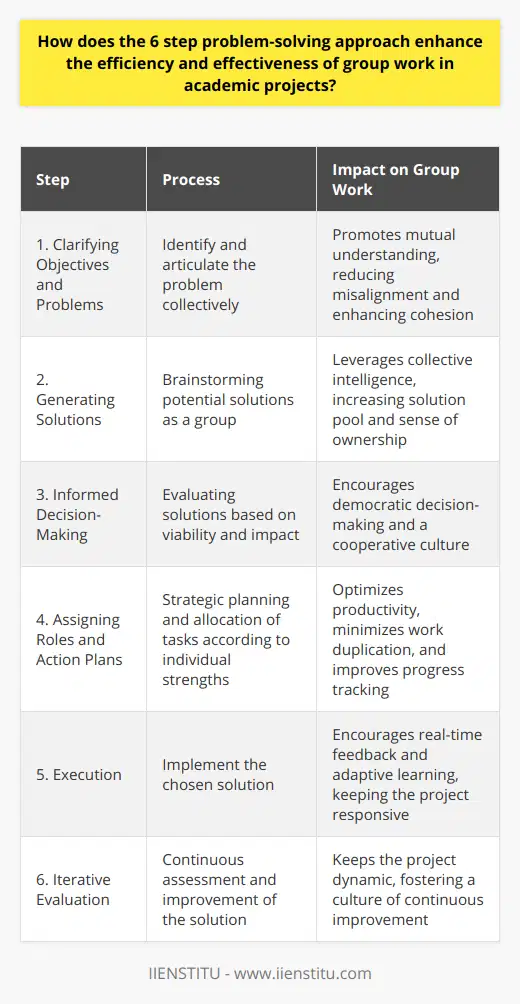
In what situations is the 6 step problem-solving approach most applicable, and how can it be adapted for various academic disciplines?
Applicability of the 6-Step Problem-Solving Approach
The 6-step problem-solving method finds applicability in scenarios necessitating systematic resolution. Its structure often benefits problem-solving in academic disciplines like science, mathematics, social studies, and even in humanities.
Adapting the 6-Step Approach in Science
In science, the process can facilitate hypothesis testing. Scientists can identify the problem, generate potential hypotheses, devise experimental protocols to test these hypotheses, conduct the experiment, analyse data, and finally, derive conclusions.
Applying the 6-Step Approach in Mathematics
Mathematics frequently employs this structured approach, particularly in problem-solving exercises. Mathematicians carefully define the problem, identify all relevant information, formulate a strategy, test this strategy, check the solution, and finally interpret it.
Use in Humanities
In humanities, this problem-solving method supports critical analysis. Researchers identify the problem or research question, gather relevant information, formulate a potential answer or thesis, argue or support this thesis, evaluate its strength, and conclude their findings.
Adaptation in Social Studies
For social studies, this methodology assists in comparative analyses, policy, and historical study. Researchers establish the problem, identify and compare information sources, formulate a potential answer, support their thesis, examine the robustness, and conclude their findings.
In summary, the 6-step problem-solving approach's utility extends across various academic fields. It offers a structured method for comprehensively addressing and resolving problems, adaptable according to the specific discipline's requirements. Its wide application in different study areas highlights the method's versatility and effectiveness.
